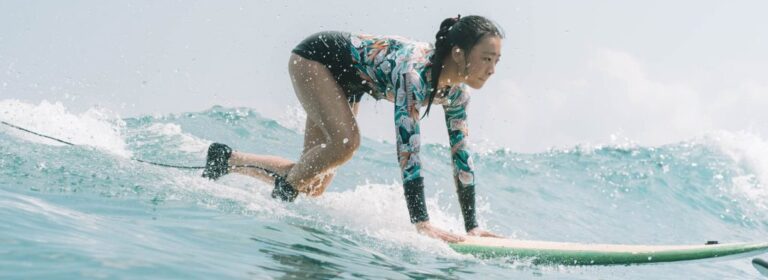The Ultimate Beginner’s Guide to Surfing: Surfing Techniques
Learning to surf might be one of the most exciting and transformative decisions you’ll ever make, but the process can be protracted and challenging. Along with having perfect timing and the ability to balance and control a board, you also need to gain knowledge of the ocean and enhance your ability to interpret waves. And with the surf conditions changing all the time, you don’t have a steady practice place.
Even with all of the challenges, surfing can be a highly fulfilling hobby, particularly for those who invest the time and energy to become skilled. Perhaps nothing feels better in life than a clear, green face being surfed down the line.
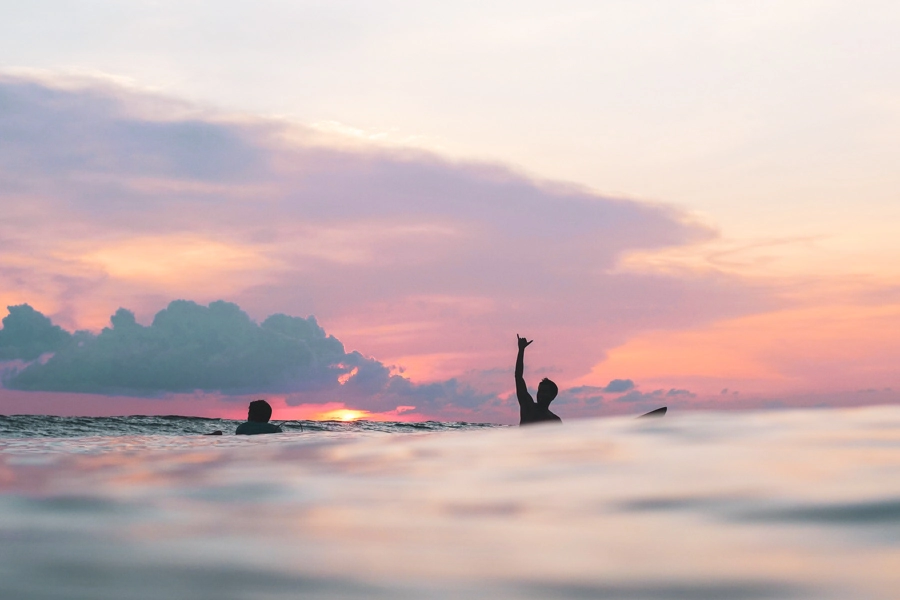
The best way to learn how to surf is to get started with some foundational basics (we highly recommend taking lessons from a skilled instructor) and then practice as much as possible. That said, there are many things that are important for beginner surfers to know when it comes to navigating the ocean, lineup, and respecting other surfers.
This guide will help you get familiar with the many elements of learning how to surf so that you can be the best kind of beginner surfer (one who has good surf etiquette and avoids pissing other surfers off… more on that later). Being a knowledgeable and respectful beginner surfer will not only help you avoid unpleasant confrontations, but you’ll have more fun along the way and also progress faster.
Here’s the lowdown on the top things you need to know when learning how to surf!
HOW TO BE A GOOD BEGINNER SURFER
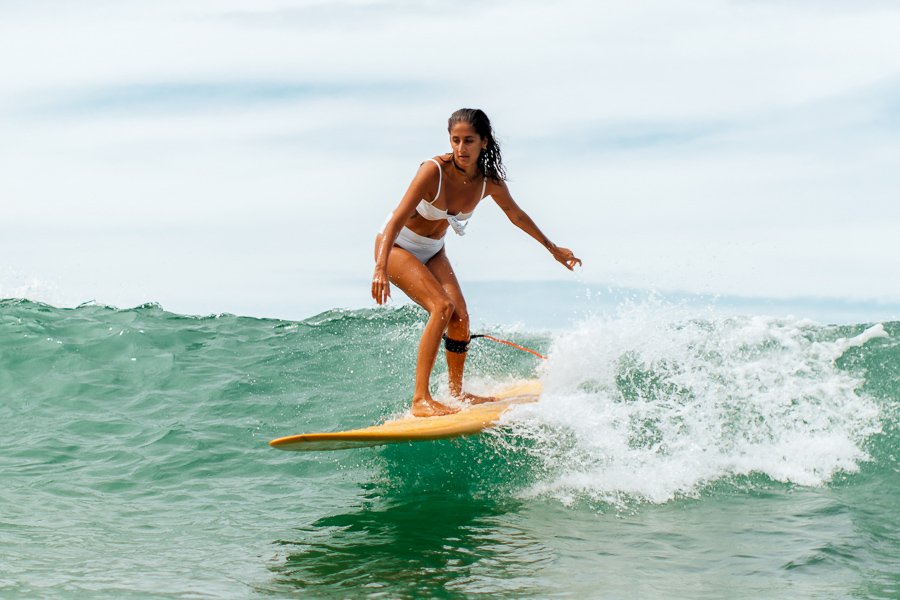
Like most pursuits, surfing is difficult to learn, so at first, you need to resign yourself to being a bit of a kook. In case you don’t know what a kook is, it’s slang for a beginning surfer—but it can also be a derogatory term for someone who is clueless and rude in the water.
While it’s okay to be the first kind of kook (we have all been beginners at one point), you don’t want to be the second kind—a person who gets in the way, ruins people’s waves, endangers themselves, and commits lots of faux pas—regardless if they are intentional or not. Follow these surfing tips to be a good beginner surfer:
1 • Choose appropriate waves to learn and surf.
We all want to ride the best waves at the best spots, but when you are learning, there are certain lineups that are simply beyond your ability level. At these waves, you are likely to get in the way and possibly get hurt, and you are also much less likely to catch waves and practice getting to your feet.
Ask experienced surfers what waves you should be surfing as a beginner, and stick to those lineups until you have developed a solid level of proficiency. And as you progress in your surfing journey, make this an ongoing practice, only paddling out to spots that are within your wheelhouse.
You will find that you get way more waves when you are surfing at spots that match your skill level, and you will also avoid pissing people off by messing up their waves.
2 • Don’t sit in the pack.
When you first start surfing, you will likely be tempted to paddle out to where everyone else is sitting and waiting for waves. After all, that must be where the best rides are, right? The problem is, you don’t yet have the skills or ocean knowledge to compete with the pack or stay out of people’s way.
This means that you are unlikely to get many waves, and very likely to mess up someone’s ride (or worse, hit someone with your board). Stick to the inside when you are learning, catching whitewater in zones where you won’t interfere in other people’s waves.
As you start to improve and move out to the main lineup, spend some time on the shoulder, waiting for scraps. Waves are typically easier to catch on the shoulder, and you will be less likely to get in people’s way. That being said, when you are surfing on the shoulder, it is important that you don’t burn anyone! Which brings us to tip number three…
3 • Don’t drop in.
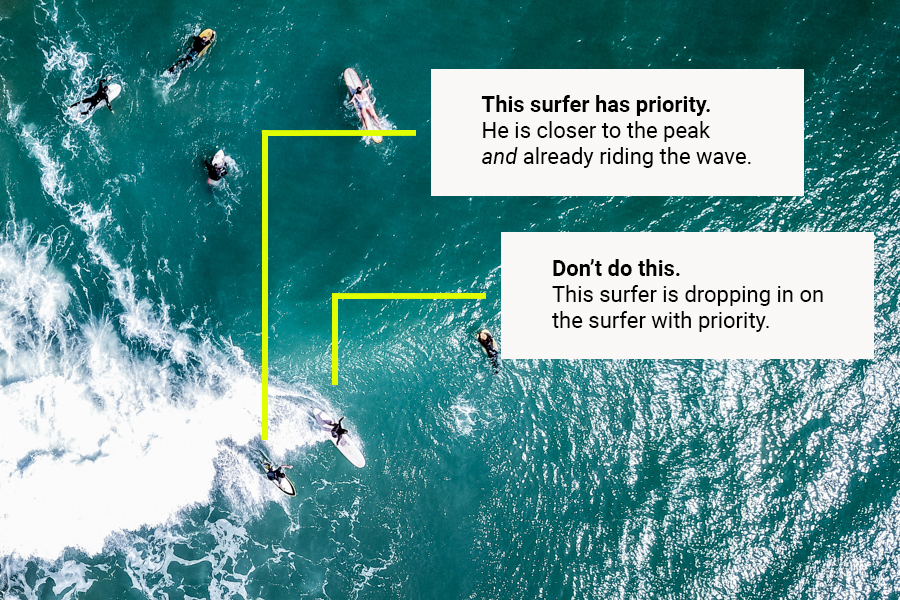
Dropping in on another surfer is a cardinal sin of surfing and should be avoided at all costs. Just don’t do it. Dropping in is when a surfer paddles into a wave that is already being ridden (i.e. a surfer with priority is up riding a wave and another surfer farther down the line takes off on the same wave in front of the priority surfer, ultimately getting in the priority surfer’s way and ruining their wave).
In most surfing lineups around the world, there is a priority system based on who has been waiting the longest and/or who is sitting farthest out. You will know whose turn it is to catch a wave because they will be deepest (and thus able to stand up before anyone else).
Once someone is up and riding a wave, it is very bad etiquette to take off in front of them (not to mention quite dangerous). When you are sitting on the shoulder catching waves, always make sure to look over your shoulder to see if anyone is already riding down the line toward you. If they are, don’t go!
It is a bit frustrating at first to see everyone surfing from deeper and getting all the waves, while you wait for the scraps, but once you start to improve and are able to compete and catch waves consistently, you will be able to sit deeper and get more waves as well! (We’ll go into some more details about dropping in below in Surf Etiquette.)
4 • Don’t back-paddle.
Once you have a basic level of competency and are ready to join the pack and sit deep, it is important to not back-paddle people. Back paddling means paddling past them to sit deeper so that you can catch the next wave, even if it is not your turn.
Unfortunately, a lot of people do this—including competent and even experienced surfers—because they are greedy and don’t respect the other people in the lineup. But just because they are doing it doesn’t make it right. On crowded days it can get a bit confusing and hard to know whose turn it is, and you are likely to see people paddling past each other and stealing priority, but on most days you know who has been waiting the longest, and it’s poor form to back-paddle them and take the next wave.
5 • Stay out of the way while paddling out.
This is a tricky one, especially for beginners who are trying to surf crowded or heavy waves (which, if you follow tips one and two, shouldn’t be a problem!). The person riding the wave always has the right of way, and it is the responsibility of the person paddling out to get out of their way.
You can typically do so by paddling out in the channel or on the shoulder, but there will be times when you find that you are in the wrong place at the wrong time, and have to make a decision between getting in someone’s way or paddling behind them and getting smashed by the wave. When this happens, always paddle behind them and take your beating!
While getting rolled by the whitewater or clipped by the lip isn’t fun for anyone, it’s way better than ruining someone’s wave, and will gain you some respect from the rest of the lineup.
TOP BEGINNER SURFER MISTAKES

There are a number of common, unnecessary mistakes that beginner surfers make that slow their progression and often lead to frustration rather than fun. The best way to improve is to learn from other people’s mistakes rather than making them yourself, so pay close attention to this list and try to avoid falling into these common traps.
1 • Picking the wrong surfboard.
One of the most common mistakes of beginner surfers is riding the wrong surfboard for their ability. Many beginner surfers attempt to surf on surfboards that are designed for more advanced surfers. In the most simple terms — the shorter and smaller the surfboard, the more difficult it is to catch waves and surf, and the longer and bigger the surfboard, the easier it is to catch waves and surf.
The big mistake is when beginner surfers attempt to surf on surfboards that are too small for their surf level which results in more difficulty paddling, catching waves, and balancing… which results in catching fewer (if any) waves, getting frustrated, and progressing much slower.
Because at the end of the day, the more waves you surf, the faster you will progress, and the fewer waves you surf, the slower and more painful your progression will be. Surfing is challenging enough — don’t make it harder by choosing the wrong board!
- PRO TIP: We’ve outlined some high-level notes below, but for the full story, check out this Guide to the Best Beginner Surfboards >>
Beginner surfers often don’t know the difference between the various different types of surfboards available, which isn’t a surprise, because there are a lot of options in your local surf shop and they can be quite confusing! Try to avoid falling into peer pressure and buying the boards that everyone else is riding. After all, most of the people you see surfing will be much more experienced than you, so the boards that work for them might not be appropriate for you at all!
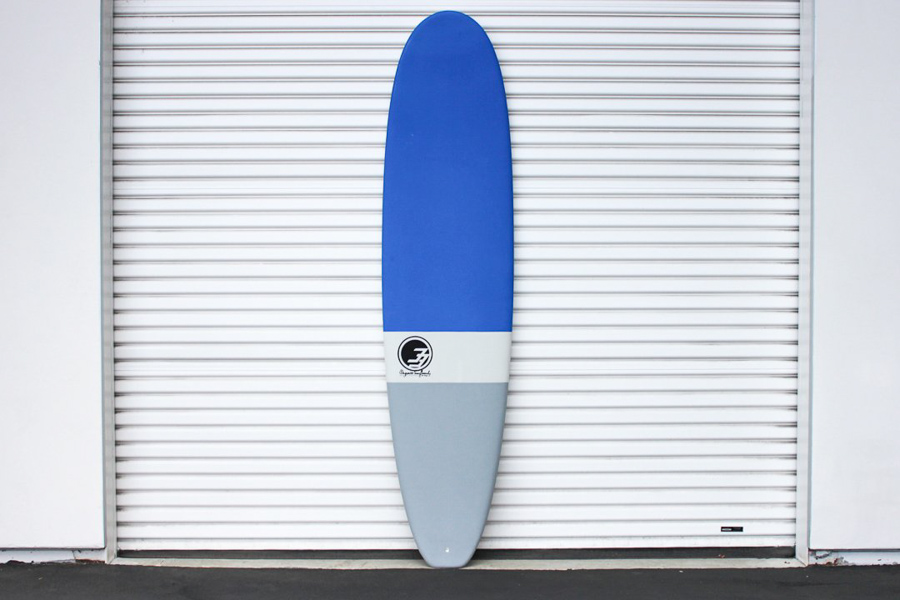
Generally speaking, the best beginner surfboard is stable, paddles well, and gets you lots of waves—which basically disqualifies high-performance shortboards, which is what many people surf. Instead, look for a longboard or a funboard, both of which have a lot of volume, making them stable and good paddlers.
You might even opt for a soft top surfboard when you are first starting, as these boards are cheaper, safer, and less likely to get damaged (or damage other people), but still provide the stable platform that you need to learn on.
Once you are catching lots of waves (open-faced waves, not whitewater) and riding down the line proficiently, you can then consider graduating to a shorter board that still has a lot of volume, such as a mid-length or fish surfboard. Then, when you get to the point where your board is the limiting factor in your performance (rather than your ability), it is finally time to progress to a high-performance shortboard.
Of course, if you find that you really enjoy trimming, you might instead decide to stay on longboards for your entire surfing career! Despite what you see in the media, there’s nothing wrong with riding longboards. The only important thing is that you have a board that is fun for you.
2 • Surfboard abuse.
Surfboards are fragile tools, so you want to take good care of them. Be aware of your surroundings when transporting and carrying your surfboard to avoid hitting your board and getting dings. Keep an eye out for dings, and always get them repaired immediately. Any hole in the glass of your board allows water into the foam, which is quite damaging and takes a lot of effort to repair.
If possible, wash your board with fresh water after a surf, as there are microscopic creatures in saltwater that can degrade the glass on your board and shorten its life.
Try to avoid leaving your board out in the sun, and you also don’t want to leave it inside your car on a hot day, as the glass can delaminate and the wax will almost certainly melt. Speaking of which, try to avoid lying your board down on its deck when you are at the beach because getting sand out of your wax is a nightmare.
3 • Not enough sun protection.
This one should be obvious, but you’d be surprised how many people make the mistake of not putting on enough sun protection and getting absolutely fried. No matter how good you think your tan is, you can still get sunburned—especially when you start catching waves and getting excited, and decide to stay out all day long.
Wear adequate sunscreen and consider covering up your back with a t-shirt or rash guard. As mentioned above, you also want to protect your board from the sun (and other elements) when it’s not being ridden, which means storing it in the house, away from windows.
4 • Paddling out in the wrong place.
Virtually everyone does this at some point when they are learning, and it takes a while to figure out lineups and where the best zones for paddling out are. But by taking a few minutes to study the lineup and see where other people are paddling out, you can start to figure out how the ocean works and where you want to paddle out.
Remember that any water that comes toward shore in the form of a wave has to go back out to sea somewhere—and that somewhere is usually in the channel or down at the bottom of the point. If you try to paddle out in the rip (where the water is flowing back out), you will make it to the lineup much more quickly. On the other hand, if you try to paddle out in the middle of the lineup, you are likely to take a bunch of waves on the head and get in people’s way.
Unfortunately, it’s not always as simple as paddling out on the shoulder. For instance, point breaks typically have strong current pushing down the line, which means that if you paddle out at the bottom of the wave, you will make it out past the lineup, but will likely have a difficult time paddling against the current up to the top of the wave. This is another reason why it’s important to only surf waves that are within your skill level (beginner waves will often have easier paddle-outs and less current).
5 • Giving up too soon.
No matter how excited you are or how good you are at other sports, surfing is going to be very challenging at first. The most important thing is not to give up. The fastest way to learn is to go as often as possible, and once you start catching waves, every little bit of progress will make you fall in love with surfing all over again. Just get past the first few days, and don’t give up!

Want to learn to surf faster? Go on a vacation to a surf camp! Surf camps are the best way for beginner surfers to make serious progress because you’ll get daily surf lessons and guidance from surf coaches every step of the way. Check out The Best Surf Camps >>


